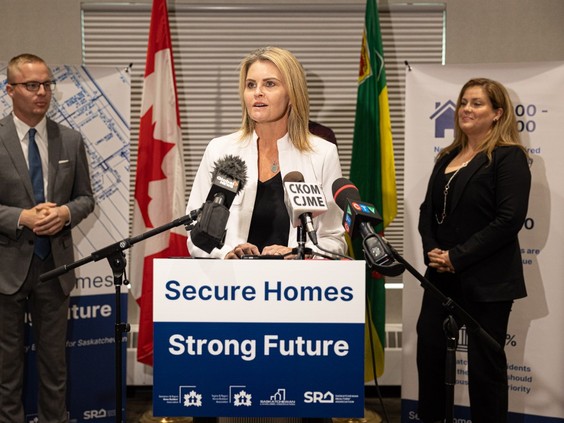
Michael Joel-Hansen
Saskatoon StarPhoenix
Some major players in Saskatchewan’s housing industry are looking to get the issue of housing on the public’s mind before the coming provincial election.
Monday morning at a media conference in Saskatoon, representatives from the Saskatoon and Regina home builders’ associations joined leaders from the Saskatchewan Realtors Association and Saskatchewan Landlord Association to release Secure Homes, Strong Future: A Housing Policy Blueprint for Saskatchewan.
The document calls for the next provincial government to implement a range of policy changes to bring down the cost of housing.
The proposed changes include reducing the provincial sales tax (PST) on new construction from six to four per cent, reinstating the home renovation tax credit and adding a tax credit for seniors so they can renovate their homes to improve functionality. The report also calls for the province to make the secondary suite incentive permanent.
It also calls for a regulatory change, calling on the province to delay implementation of tier three of the National Building Code, which is set to go into effect in January.
Saskatchewan Realtors’ Association CEO Chris Guérette said the province’s record population growth has put a strain on the housing supply and the rental market. The current provincial government’s plan to grow the population to 1.4 million by 2030 means 60,000 to 80,000 new housing units will be needed to meet demand, she added.
“A plan for growth cannot exclude bringing more housing to market.”
Guérette said providing an affordable housing market is important for attracting and keeping residents in Saskatchewan.
Taking questions from media, Regina and Region Homebuilders’ Association CEO Stu Niebergall said while Saskatchewan has been seeing increased housing costs, the housing market is still providing good value for people. However, without changes the province could face challenges like those being seen in centres like Calgary, he said.
“We have the opportunity to get ahead of these challenges before they really take hold here.”
Niebergall said some of the blame for the current affordability challenges fall on the decision to shift toward a ‘growth pays for growth’ funding structure, where infrastructure costs in new developments fall on home buyers in those areas. In the past there was a different approach, he noted.
“The infrastructure to support housing was a shared cost amongst the entire community.”
The report calls from the provincial government to do an audit of its own buildings and lands to see if any can be repurposed to develop housing.
Saskatoon and Region Homebuilders’ Association CEO Nicole Burgess said other provinces have done this successfully.
“We’ve seen this approach work well in cities like Calgary and Edmonton and we believe that similar success can be achieved here right in Saskatchewan,” she said.
Burgess said the province has also downloaded the cost of supplying new land for schools onto municipalities. This led to the City of Saskatoon putting a levy in place to help pay for land for new high schools, which will be costly for buyers, she said.
“This new cost, which will add roughly $2,000 per new single family home starting Jan. 1, will ultimately be passed on to new home owners, further eroding affordability.”
Burgess said availability of labour to build new housing also has to be dealt with and will require action from the provincial and federal governments.
The blueprint also calls for changes to help the rental market, including more funding for the Office of Residential Tenancies to hire hearing officers and other staff.
Saskatchewan Landlords Association CEO Cameron Choquette noted more than 30 per cent of people in the province live in rental housing. Growing demand for rental housing has led to some neighbourhoods in the province’s two major cities having vacancy rates of below one per cent, he said.
“Healthy is about three and a half to four (per cent), where there’s that natural churn of tenants going back and forth.”
Choquette said between January and June this year, 600 rental units were built in Saskatoon. Over that same time period in 2023, between 5,000 and 6,000 people moved to the city, which creates a real issue in terms of affordability, he added.
“That’s the imbalance that the four of us and our associations are trying to illustrate that demand is outpacing supply in a serious way.”

